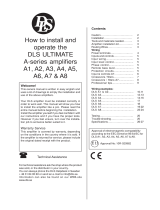
Input Level control - GAIN
The GAIN control, MIN – MAX,
matches the output of your radio
to the input of the amplifier. After
installation is complete, make sure
the input of the amplifier is turned
down all the way to MIN. After tur-
ning the head unit ON, you can
adjust the GAIN level, A normal
setting is from 12 - 14 o’ clock.
The high pass filter
blocks very low frequen-
cies from reaching the
speakers, mostly used
to protect small spea-
kers from deep bass.
High Pass filter (HPF) - CC-2 / CC-4 / CC-44
The low pass filter is
mostly used for sub-
woofers. It will allow low
frequencies only and
blocks higher frequen-
cies. A typical setting is
60 – 70 Hz.
The
CC-2 is a 2-channel amplifier.
Can be used for a pair of stero speakers or a sub-
woofer connected in mono bridge mode.
The amplifier has the following filters / features:
q Lowpass filter adjustable from 50 to 500 Hz, the
filter can be switched off.
q Highpass filter adjustable from 50 to 500 Hz, the
filter can be switched off.
q Bass EQ 0 - + 6 dB adjustable
5
The
CC-4 / CC-44 are 4-channel amplifiers for
use with a front speaker and a subwoofer, or two
speaker pairs in front and rear.
The amplifier has the following filters / features:
q Lowpass filter adjustable from 50 to 500 Hz, the
filter can be switched off.
q Highpass filter adjustable from 50 to 500 Hz, the
filter can be switched off.
Set the push button to ON and the HPF / LPF button
to HPF (button OUT) to activate the filter, or OFF
if you want to run the amplifier in full range mode
without limiting the frequency range.
Set the push button to ON and the HPF / LPF but-
ton to LPF (button IN) to activate the filter, or OFF
if you want to run the amplifier in full range mode
without limiting the frequency range.
The CC4 / CC-44 model have the same setup of
filters on channels 1 & 2 and 3 & 4 as well.
Low Pass filter (LPF) - CC-2 / CC-4 / CC-44 Features on each model
Bass EQ CC-2 / CC-500 / CC-1000
Bass EQ or Bass boost is used
to increase the bass volume at a
specific frequency (60 Hz).
You can adjust the amplification
continiously from 0 dB ( no amplifi-
cation ) to + 6 dB.
The CC-500 / CC1000 are 1-channel mono
amplifiers.
Can be used for one or more subwoofers
The amplifiers have the following filters / fea-
tures:
q Lowpass filter adjustable from 35 to 250 Hz
q Remote level control.
q Phase switch 0 - 180 degrees
q Subsonic filter
q Selectable LPF slopes 12 / 24 dB
q Bass EQ 0 - + 6 dB adjustable
The low pass filter is
mostly used for sub-
woofers. It will allow low
frequencies only and
blocks higher frequen-
cies. A typical setting is
60 – 70 Hz.
Low Pass filter (LPF) / Phase shift
This function is used to compensate
for the bass box function and to
adjust for your own taste of bass.
Set level control at 0 dB if you want
it to be inoperative.
Phase switch - CC-500 / CC-1000
To get the best possible front stage from your sub-
woofer installation you can choose the phase shit
between 0 (button OUT) or 180 degrees (button IN)
Listen to the bass and choose the position that gives
the best front stage in your vehicle.
The LPF filter has two selectable
slopes 12 or 24 dB, choose the
slope that sounds best in your
installation.
Subsonic filter on CC-500 / CC1000
The subsonic filter reduces the
lowest frequencies below 30 Hz.
In ON-position the bass sound
becomes more tight.
Choose the position that best suits
your ears and the installation.












